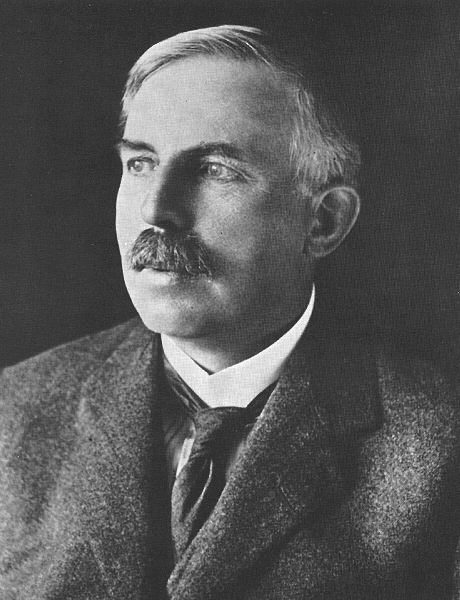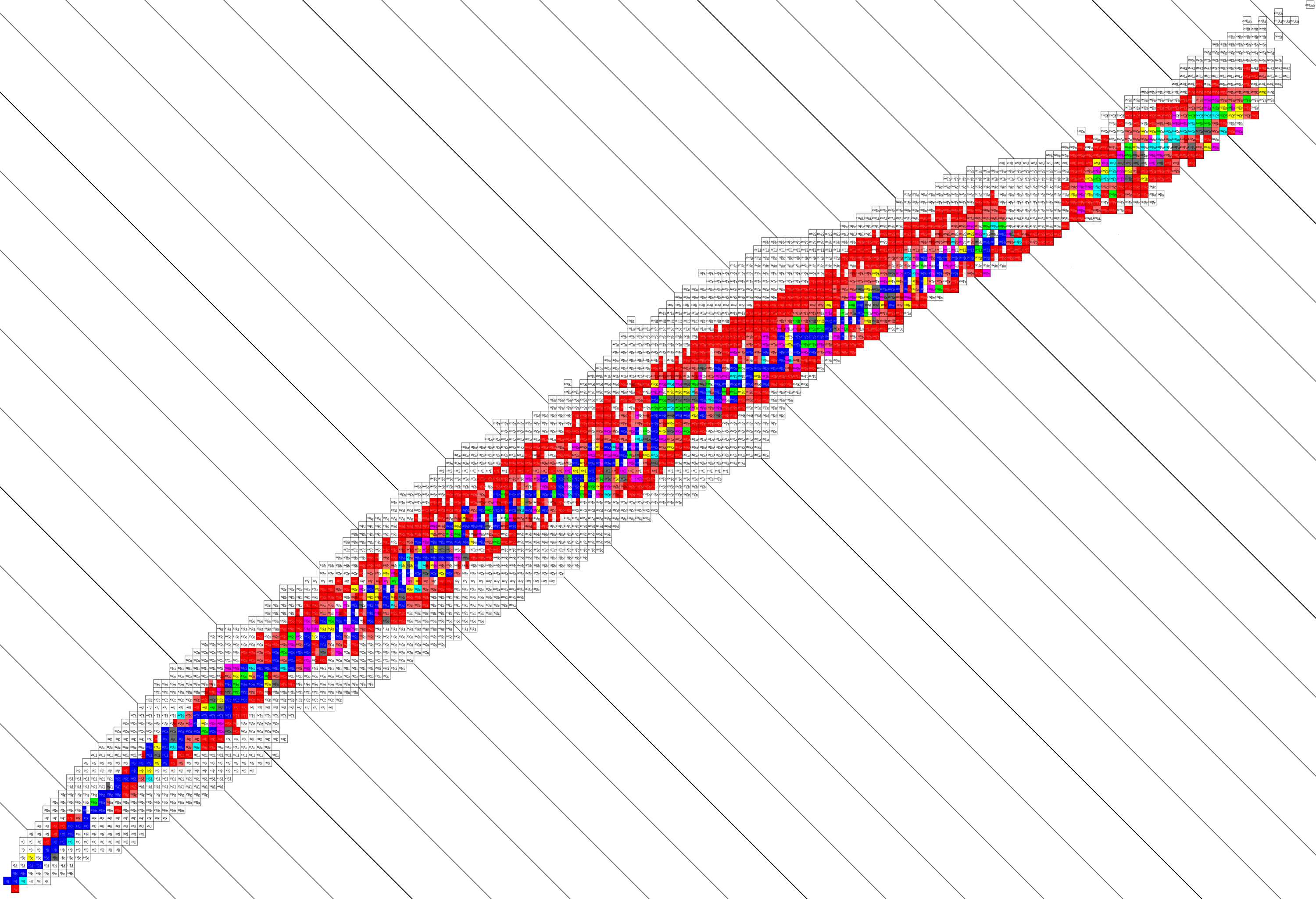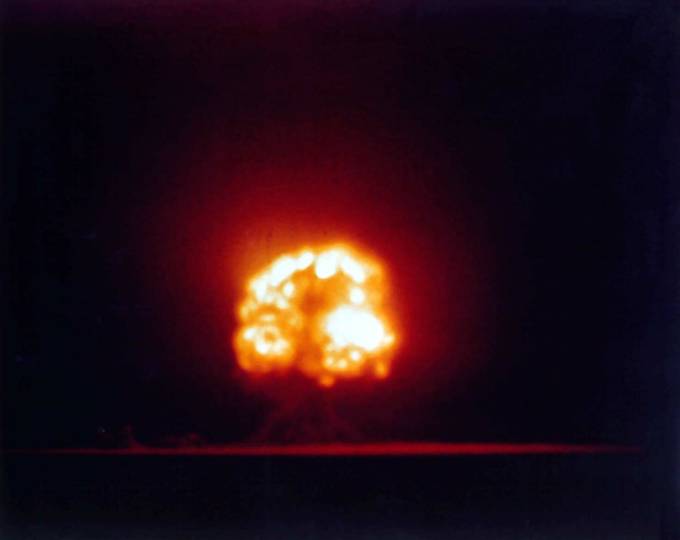Building the atom
Richard belongs to Jayne
And Jayne belongs to yesterday.
How can I go on
When every alpha particle hides a neon nucleus?
Billy Bragg, Richard
Rutherford's planetary model of the atom
Ernst Rutherford was interested in exploring the basic structure of the atom. He performed a special experiment known as scattering. In a scattering experiment, one takes something with an unknown shape or structure. That is the target. Then one throws something at the target. That is the scatterer. Think of taking a target, which might be a plate. You are asked to determine the size of the plate without feeling it or measuring it directly. One way to do that is to use a scattering experiment. You hang the plate in a hallway. You know the area of the hallway; you want to know the area of the plate. The plate is your target and at your target you throw tennis balls. You throw them randomly. Some will pass the plate and roll on. Others will hit the plate and bounce back. How does this help you figure out the size of the plate?Easy! You know that the ratio of the area of the plate to the area of the hall must be equal to the number of balls scattered back at you. That is
Aplate / Ahall = # balls scattered / # balls thrown
Since we know Ahall, the number of balls thrown, and the number of balls scattered back, we can figure out Aplate - the area of the plate. So with that sort of scattering experiment, you can learn the size of the plate, its area, without ever measuring it, or even seeing it.
 We can take this a bit further. What if we replace the plate with a ball.
Now the target is a sphere. The tennis balls we throw won't just
scatter back or pass by. They might also be scattered at different
angles, this way and that, depending on where they hit the ball. If we predict all that - all the possible ways the balls can be scattered by the spherical target -
we can build a model for the scattering pattern that we'd expect for a ball of a certain size. Given an observed scattering pattern, we would fit that pattern to our model to determine the size of the ball.
So you can see that scattering
is a very powerful method for learning the basic size and shape of objects
that you can't see or directly measure.
We can take this a bit further. What if we replace the plate with a ball.
Now the target is a sphere. The tennis balls we throw won't just
scatter back or pass by. They might also be scattered at different
angles, this way and that, depending on where they hit the ball. If we predict all that - all the possible ways the balls can be scattered by the spherical target -
we can build a model for the scattering pattern that we'd expect for a ball of a certain size. Given an observed scattering pattern, we would fit that pattern to our model to determine the size of the ball.
So you can see that scattering
is a very powerful method for learning the basic size and shape of objects
that you can't see or directly measure.
For Rutherford, the target was a thin gold foil made of a layer or sheet of gold atoms. Since he knew the mass of the gold foil, and the molar mass of gold, he could calculate the number of gold atoms that the foil was made of. For Rutherford, the scatterer was an α particle - which we now know to be the nucleus of a helium atom, made of two neutrons and two protons. He would throw the α particles at the foil and look to see if the particles were scattered or if they passed through the foil unhindered.
What Rutherford found was remarkable. When he cast the α particles at the foil, most of the particles passed through the foil unhindered! How could that be? To our senses, the foil seems to be a continuous surface. Rutherford's result implied that the foil was, at the microscopic level, quite porous. In fact, it was mostly empty space! Interpreting his result, he developed the basic model of the atom that we still use today - the planetary model.
Now there were other possibilities. The atom might have been constructed like the positive and negative charges of a salt crystal. But Rutherford didn't think that was the way it worked. He proposed there is a nucleus where most of the mass of the atom is concentrated. The nucleus is like the Sun. Around that nucleus orbit the electrons that are much lighter. Those are the planets. Rutherford didn't know about the strong force that acts between nucleons and holds them close together in the nucleus of the atom, on the order of 1 Fermi (= 1 x 10-15m).
Rutherford knew that atoms (his "Solar System") were roughly of diameter
datom = 3 x 10-10 m
He wanted to known the size of the nucleus (his "Sun"). Applying our "balls in the hall" model to Rutherford's data, the ratio to consider isAnucleus / Afoil = # α particles scattered / # α particles thrown
Since he knew Afoil and the number of α particles thrown and scattered back, he could compute Anucleus. He found that Anucleus = 10-28 m2 so that the diameter of the nucleus wasdnucleus = Anucleus1/2 < 1 x 10-14 m
That's shocking! The difference between the diameter of the nucleus and the diameter of the atom is nearly a factor of 100,000. While a billion Earths can fit in a volume the size of our Sun, a million billion nuclei can fit inside the volume of a single atom.Isotopes
The tour de force experiment of Rutherford led to the general acceptance of the planetary model of the atom. The protons are concentrated in a small nucleus of heavy mass and positive charge. About that nucleus orbit the relatively light and negatively charged electrons.Now that we have the subatomic building blocks of the atom, the protons and electrons, we can construct atoms and compare the mass of what we build to what is observed in Nature. Let's start with the fifth element in the Periodic Table which is boron. If we go to a mine and dig up some boron, refine it, then weigh a mole of it, we will find that the molar mass is MB = 10.81 g/mol. We can compute the mass of a mole of each of the subatomic particles. Here's what we find.
Particle mass and molar mass
particle name mass molar mass
electron 0.000911 X 10-27 kg 0.000549 g
proton 1.672623 X 10-27 kg 1.007276 g
neutron 1.674929 X 10-27 kg 1.008665 g
 Of course, it's the neutrons. It took many year to discover
the neutron. Thomson discovered the electron in 1897 (after it was
predicted to exist, and even named, by Stoney in 1891). Rutherford
discovered the proton in 1919. But it was not until 1932 that James Chadwick
discovered the neutron. Particles that are electrically neutral are difficult
to work with. They are difficult to trap, to direct, and to
detect.
Of course, it's the neutrons. It took many year to discover
the neutron. Thomson discovered the electron in 1897 (after it was
predicted to exist, and even named, by Stoney in 1891). Rutherford
discovered the proton in 1919. But it was not until 1932 that James Chadwick
discovered the neutron. Particles that are electrically neutral are difficult
to work with. They are difficult to trap, to direct, and to
detect.
 Let's take the difference
in mass between the atom of 4He and the six particles that it is
composed of. That difference is m = 0.05044 x 10-27 kg and
the corresponding energy is
E = m c2 = 4.5 x 10-12 J = 2.7 x 1012 J/mol.
Let's take the difference
in mass between the atom of 4He and the six particles that it is
composed of. That difference is m = 0.05044 x 10-27 kg and
the corresponding energy is
E = m c2 = 4.5 x 10-12 J = 2.7 x 1012 J/mol.